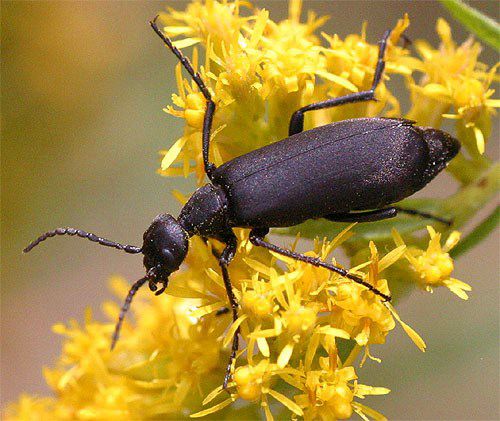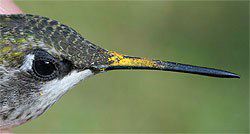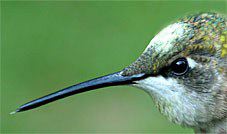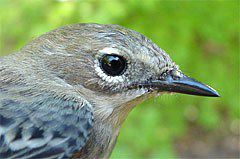|
|
|||
THIS WEEK at HILTON POND
8-14 October 2003
Installment #193---Visitor #
(Back to Preceding Week; on to Next Week)
|
|
|||
THIS WEEK at HILTON POND
8-14 October 2003
Installment #193---Visitor #
(Back to Preceding Week; on to Next Week)
|
THE IMPORTANCE OF POLLINATORS After a quick glance at graphics on this page, it might appear we went a little heavy on yellow. Indeed, all but the bottom four photos depict an insect perched on Goldenrod flower heads at Hilton Pond Center, so you might conclude that this week's installment is about Solidago--the numerous species of brilliant yellow native Goldenrods that brighten autumn days. Actually, however, our current photo essay is about the insects themselves--and about other organisms that play critical roles as pollinators of flowering plants. Even though we'd all be in a heap of trouble without pollinators, most humans ignore their value and at worst eradicate them with indiscriminate pesticide application, habitat destruction, and other endeavors. Pollinators are worth protecting for their own sakes, but we would do well to remember that these creatures facilitate reproduction in 90% of the world's flowering plants, and that--on average--one in every three bites of food we humans take comes courtesy of an animal pollinator. 
All text & photos © Hilton Pond Center We've been thinking a lot about pollination, in part because this week we were in College Park, Maryland taking part in a major meeting of the North American Pollinator Protection Campaign (NAPPC). The mission of this group--made up of researchers, educators, government officials, conservationists, and industry representatives from the U.S, Mexico, and Canada--is "to encourage the health of resident and migratory pollinating animals in North America," and there are a lot more of these animals than one might realize. When one hears the word "pollinator," one typically thinks of Honey Bees, whose value and industrious visits to flowers are known even to a casual nature observer. Indeed, European Honey Bees, Apis mellifera, are significant pollinators of many agricultural crops and native plants; the massive orange pollen sac on the hind leg of a worker Honey Bee (above left) is evidence of her pollen-transferring activities. Honeybees, however, are non-native; they were brought from Europe by early settlers who wanted honey on their breakfast biscuits, so these imported insects very likely displaced many native pollinators already hard at work across North America. Among the most common native pollinators are "solitary bees," so-called because they don't assemble in hives or colonies like social Honey Bees. Solitary bees--some less than an eighth of an inch long--are at least as busy as Honeybees but are often overlooked even though they pollinate valuable commercial crops such as strawberries. Perhaps the most visible native solitary bee is the roly-poly inch-long Carpenter Bee, Xylocopa virginica (female above right), which resembles social Bumble Bees. All these big pollinator bees have fuzzy thoraxes--the yellow body segment behind the head--but can be differentiated because the top of the Bumble Bee's abdomen is fuzzy while that of the Carpenter Bee is smooth and shiny. As small as the smaller solitary bees are some flies that also pollinate, including the quarter-inch-long unidentified species (Eristalis, perhaps?) in the photo below left. Some flies superficially resemble bees since both have wings that are transparent and membranous, Another pollinating group that is often forgotten is the wasps, which--like their bee relatives--have four wings. And then we have the beetles. There are more beetles in the world than any other insect group--750,000 species and counting--so it stands to reason some of them would be involved in the business of pollinating. Many adult butterflies are also nectar eaters and important pollinators--which shouldn't be a surprise when we consider how many millions of exotic Butterfly Bushes, Buddleja davidii, have been planted in recent years by homeowners trying to attract these colorful insects. As the Viceroy departed, our attention was attracted to an unusual day-active moth that pollinates flowers. It was an inch-long Yellow-collared Scape Moth, Cisseps fulvicollis, whose uncoiled red proboscis can be seen probing a Goldenrod inflorescence in the photo above right. The vast majority of moths are nocturnal, of course, and some are very important pollinators of night-blooming flowers, especially in desert regions of the southwestern U.S. and Mexico. For example, the female Yucca Moth, Tegeticula maculata , has mouth parts that allow her to gather a ball of pollen under which she lays her eggs in the stigma of a yucca flower--which also insures that yucca cross-pollination occurs.
In the eastern U.S. and Canada flying animals other than bats are also important pollinators, but these have feathery wings and happen to be very dear to our hearts here at Hilton Pond Center. We refer to Ruby-throated Hummingbirds, Archilochus colubris, which visit all sorts of native and imported flowers in search of nectar, from Red Columbines in spring to the Cardinal Flowers of autumn. For anyone who has noticed a hummer with a smear of white or yellow powder on its forehead or bill (below), there can be little doubt that hummingbirds play a role in pollinating. The hummer's long thin bill is perfectly adapted to the deep tubular flower of plants like Trumpet Creeper, Campsis radicans--perhaps the single most important native hummingbird plant in eastern North America (bottom photo).  . . Birds, beetles, bats, bees, butterflies--even wasps and flies. We've touched upon all these pollinators but barely scratched the surface in describing their diversity and how important they are, both environmentally and economically. In short, without pollinators the world of nature AND humans goes hungry, so animals that carry out this business of flower fertilization need understanding and protection--not just at Hilton Pond but everywhere they occur. Banana Bat photo courtesy MarcoTschapka For more information on the North American Pollinator Protection Campaign, please visit its Web site. NAPPC is coordinated by the Coevolution Institute. NOTE: Be sure to scroll down for an account of all birds banded or recaptured during the week, as well as some other interesting nature notes. "This Week at Hilton Pond" is written and photographed by Bill Hilton Jr., executive director of Hilton Pond Center for Piedmont Natural History. You may wish to consult our Index of all nature topics covered since February 2000. You can also use the on-line Search Engine at the bottom of this page. For a free, non-fattening, on-line subscription to "This Week at Hilton Pond," just send us an E-mail with Subscribe in the subject line. Please be sure to configure your spam filter to accept E-mails from hiltonpond.org. |
|
Make direct donations on-line through
Network for Good: |
|
|
LIKE TO SHOP ON-LINE?
Donate a portion of your purchase price from 500 top on-line stores via iGive: |
|
|
Use your PayPal account to make direct donations:
|
|
|
|
|
|
|
SPECIES BANDED THIS WEEK: * = New species for 2003 WEEKLY BANDING TOTAL 10 species 24 individuals
YEARLY BANDING TOTAL (2003) 58 species 971 individuals
BANDING GRAND TOTAL (since 28 June 1982) 123 species 43,085 individuals
NOTABLE RECAPTURES THIS WEEK (with original banding date, sex, and current age) Northern Cardinal (1) 07/29/02--2nd year female
VAGRANT HUMMINGBIRDS None this week All text & photos © Hilton Pond Center |

Yellow-rumped (Myrtle) Warbler OTHER SIGHTINGS OF INTEREST --Nearly all the warblers and thrushes banded this week at Hilton Pond Center were laden with yellow fat. These energy-rich deposits are laid down primarily in the furcula, the wishbone area below the throat. It's curious that so much fat is put on well before these migrants get to a coastal "jumping off" point as they make their way to Central or South America. --Since no Ruby-throated Hummingbirds were banded this week at the Center, we suspect our "summer hummer" activity is over for the year. Bring on the winter vagrants! |
|
|
|
Up to Top of Page Back to This Week at Hilton Pond Center Current Weather Conditions at Hilton Pond Center |
 post questions for The Piedmont Naturalist |
Join the |
Search Engine for |
|
|